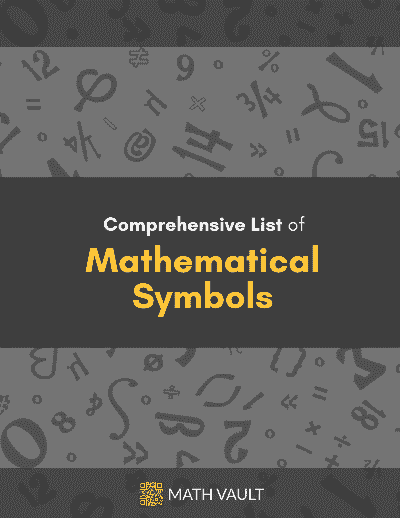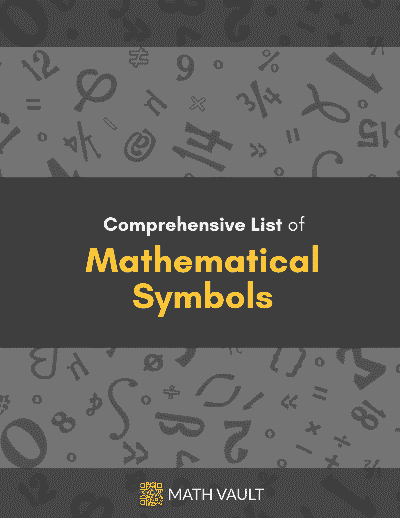In philosophy and mathematics, logic plays a key role in formalizing valid deductive inferences and other forms of reasoning. The following is a comprehensive list of the most notable symbols in logic, featuring symbols from propositional logic, predicate logic, Boolean logic and modal logic.
For readability purpose, these symbols are categorized by their function into tables. Other comprehensive lists of symbols — as categorized by subject and type — can be also found in the relevant pages below (or in the navigational panel).
Table of Contents

Prefer the PDF version instead?
Get the master summary of mathematical symbols in eBook form — along with each symbol’s usage and LaTeX code.
Constants
In logic, constants are often used to denote definite objects in a logical system. The following table features the most notable of these — along with their respective example and meaning.
| Symbol Name | Explanation | Example |
|---|---|---|
| $a, b, c$ | General constants (within a logical system) | $b \ge a_1 + a_2$ |
| $\mathbb{B}$ | Boolean domain | In Boolean logic, $\mathbb{B} = \{ 0 ,1\}$. |
| $\top$ (or $1$ in Boolean logic) | Tautology, Truth value ‘true’ | $P \lor \lnot P \equiv \top$ |
| $\bot$ (or $0$ in Boolean logic) | Contradiction, Truth value ‘false’ | $Q \land \lnot Q \equiv \bot$ |
Variables
Similar to other fields in mathematics, variables are used as placeholder symbols for varying entities in logic. The following table documents the most notable of these — along with their respective example and meaning.
| Symbol Name | Explanation | Example |
|---|---|---|
| $x, y, w, z$ | Quantification variables | $x_1 + x_2 = y$ |
| $\mathbf{x}, \mathbf{y}, \mathbf{w}, \mathbf{z}$ | Metavariables for quantification variables | For all variables $\mathbf{x}_1$ and $\mathbf{x}_2$, ‘$\mathbf{x}_1 = \mathbf{x}_2$’ is a formula. |
| $f, g, h$ | Function symbols | $h\left( f_1(x), g(x, y) \right)$ |
| $\mathbf{s}, \mathbf{t}$ | Metavariables for terms | For all terms $\mathbf{t}_1$ and $\mathbf{t}_2$, ‘$f(\mathbf{t}_1, \mathbf{t}_2)$’ is a term. |
| $P, Q, R$ | Propositional / Predicate symbols | $P(x, a) \land Q_1(z)$ |
| $\alpha, \beta, \gamma, \phi, \psi$ | Metavariables for formulas | For all formulas $\alpha$ and $\beta$, $\alpha \land \beta \equiv \beta \land \alpha$. |
| $\Sigma, \Phi, \Psi$ | Metavariables for set of sentences | If $\Sigma$ is inconsistent, then so is $\Sigma \cup \Phi$. |
| $\mathcal{L}$ | Metavariable for formal languages | If $\mathcal{L}$ is a language with equality and constant $a$, then ‘$a = a$’ is a formula in $\mathcal{L}$. |
Operators
Operators are symbols used to denote mathematical operations, which serve to take one or multiple inputs to a similar output. In logic, these operators include logical connectives from propositional/modal logic, quantifiers from predicate logic, as well as other operators related to syntactic substitution and semantic valuation.
Unary Logical Connectives
| Symbol Name | Explanation | Example |
|---|---|---|
| $\lnot P$, $\sim\!\!P$, $\overline{P}$ | Negation of $P$ (not $P$) | $\lnot \lnot P \equiv P$ |
| $\Diamond P$ | Possibly $P$ | If $\Diamond P$, then $\Diamond \Diamond P$. |
| $\Box P$ | Necessarily $P$ | If $\Box P$, then $\neg \Diamond \neg P$. |
Binary Logical Connectives
| Symbol Name | Explanation | Example |
|---|---|---|
| $P \land Q$ | Conjunction ($P$ and $Q$) | $P \land P \equiv P$ |
| $P \lor Q$ | Disjunction ($P$ or $Q$) | $\neg (P \lor Q) \equiv$ $\neg P \land \neg Q$ |
| $P \veebar Q$, $P \oplus Q$ | Exclusive disjunction ($P$ xor $Q$) | $P \oplus Q \equiv$ $(P \lor Q) \land \neg(P \land Q)$ |
| $P \uparrow Q$ | Negation of conjunction ($P$ nand $Q$) | $P \uparrow Q \equiv \neg (P \land Q)$ |
| $P \downarrow Q$ | Negation of disjunction ($P$ nor $Q$) | $P \downarrow Q \equiv \\ (\neg P \land \neg Q)$ |
| $P \to Q$ | Conditional (If $P$, then $Q$) | For all $P$, $P \to P$ is a tautology. |
| $P \not\to Q$ | Non-conditional (Not ‘if $P$, then $Q$’) | $P \not\to Q \equiv P \land \neg Q$ |
| $P \leftarrow Q$ | Converse conditional (If $Q$, then $P$) | $Q \leftarrow (P \land Q)$ |
| $P \not\leftarrow Q$ | Converse non-conditional (Not ‘if $Q$, then $P$’) | $(P \to Q) \land \\ (P \not\leftarrow Q)$ |
| $P \leftrightarrow Q$ | Biconditional ($P$ if and only if $Q$) | $P \leftrightarrow Q \equiv$ $(P \to Q) \land (P \leftarrow Q)$ |
| $P \not\leftrightarrow Q$ | Non-biconditional (Not ‘$P$ if and only if $Q$’) | If $P \not\to Q$, then $P \not\leftrightarrow Q$. |
Generalized Logical Connectives
| Symbol Name | Explanation | Example |
|---|---|---|
| $\displaystyle \bigwedge_{i=m}^n P_i$ | Generalized conjunction ($P_m \land \cdots \land P_n$) | $\displaystyle \bigwedge_{i=1}^n [i \ne (i+1)]$ |
| $\displaystyle \bigvee_{i=m}^n P_i$ | Generalized disjunction ($P_m \lor \cdots \lor P_n$) | $\displaystyle \neg \left(\bigvee_{i=1}^n P_i \right) = \bigwedge_{i=1}^n \neg P_i$ |
Quantifiers
| Symbol Name | Explanation | Example |
|---|---|---|
| $\forall \mathbf{x}$ | Universal quantification (For all $\mathbf{x}$) | $\forall x >0 \, (e^x > 1)$ |
| $\exists \mathbf{x}$ | Existential quantification (There exists $\mathbf{x}$) | $\exists x \forall y \, (x^2 \le y^2)$ |
| $\exists ! \mathbf{x}$ | Uniqueness quantification (There is a unique $\mathbf{x}$) | $\exists !\, q, r \in \mathbb{Z}\,$ $(n=dq+r \, \land$ $0 \le|r|<d)$ |
| $\mathrm{N} \mathbf{x}$, $\nexists \mathbf{x}$ | Non-existence quantification (There is no $\mathbf{x}$) | $\mathrm{N}x P(x) \equiv \\ \forall x \, \neg P(x)$ |
| $\exists_n \mathbf{x}$ | Numerical quantification (There are exactly $n$ $\mathbf{x}$) | $\exists_3 x \in \mathbb{Z}\, (5 < x < 9)$ |
| $\exists_{\ge n} \mathbf{x}$ | Numerical quantification (There are at least $n$ $\mathbf{x}$) | $\exists_{\ge 2} x \, Q(x) \equiv$ $\exists x \exists y \, (Q(x) \land$ $Q(y) \land x \ne y)$ |
| $\exists_{\le n} \mathbf{x}$ | Numerical quantification (There are at most $n$ $\mathbf{x}$) | $\exists_{\le 10} x \, (x^2 \le 100) \equiv$ $\neg \left(\exists_{\ge 11} x \, (x^2 \le 100)\right)$ |
Substitution-based Operators
| Symbol Name | Explanation | Example |
|---|---|---|
| $\mathbf{t}[\mathbf{x}/\mathbf{t}_0]$ | Substituted term (term $\mathbf{t}$ with occurences of $\mathbf{x}$ replaced by $\mathbf{t}_0$) | $(x^2 + y)[x/1][y/5] =$ $1^2 + 5$ |
| $\mathbf{\alpha}[\mathbf{x}/\mathbf{t_0}]$ | Substituted formula (formula $\mathbf{\alpha}$ with free occurrences of $\mathbf{x}$ replaced by term $\mathbf{t_0}$) | $(\forall x (x = y)) [x/a] =$ $\forall x (x = y)$ |
Valuation-based Operators
| Symbol Name | Explanation | Example |
|---|---|---|
| $\mathbf{t}^{\sigma}$ | Referent of term $\mathbf{t}$ under valuation $\sigma$ | $\left(f(a,b)\right)^{\sigma} =$ $\mathrm{father}(\mathrm{Al}, \mathrm{Bob})$ |
| $\alpha^{\sigma}$ | Truth value of formula $\alpha$ under valuation $\sigma$ | If $P^{\sigma}$ is a symmetric relation, then $\left(P(x, y)\right)^{\sigma} = \\ \left(P(y, x)\right)^{\sigma}$ |
| $\sigma (\mathbf{x}/u)$ | Revaluation of $\sigma$ where variable $\mathbf{x}$ is revalued as $u$ | $(\forall x \, \alpha)^{\sigma} = \top$ if and only if for all $u$ in the universe of discourse $U$, $\alpha^{\sigma (x/u)} = \top$. |
Relational Symbols
In logic, relational symbols play a key role in turning one or multiple mathematical entities into formulas and propositions, and can occur both within a logical system or outside of it (as metalogical symbols). The following table documents the most notable of these symbols — along with their respective meaning and example.
| Symbol Name | Explanation | Example |
|---|---|---|
| $\mathbf{t}_1 = \mathbf{t}_2$ | Identity symbol in a logical system with equality | ‘$\neg \left(1 = s(1) \right)$’ is a formula in the language of first-order arithmetic. |
| $\alpha \! \implies \! \beta$ | Sentence $\alpha$ implies sentence $\beta$ | $\forall x \, (x \ge 1) \! \implies 1 \ge 1$ |
| $\alpha \! \impliedby \! \beta$ | Sentence $\alpha$ is implied by sentence $\beta$ | $5 \mid x \! \impliedby \! 5 \mid 7x$ |
| $\alpha \equiv \beta$, $\alpha \Leftrightarrow \beta$, $\alpha \! \iff \! \beta$ | Sentence $\alpha$ and $\beta$ are logically equivalent | $\neg (P \to Q) \equiv \\ P \land \neg Q$ |
| $\sigma \models \alpha$ | Valuation $\sigma$ satisfies formula $\alpha$ | If $\phi^{\sigma} = \top$, then $\sigma \models \phi$. |
| $\Phi \models \phi$ | Set of sentences $\Phi$ entails sentence $\phi$ ($\phi$ is a logical consequence of $\Phi$) | If $\Phi \models \phi$, then $\Phi \cup \Psi \models \phi$. |
| $\Phi \nvDash \phi$ | Set of sentences $\Phi$ does not entail sentence $\phi$ | $\{P \to Q, Q \to R \} \nvDash R$ |
| $\models \phi$ | Sentence $\phi$ is a tautology | $\models \forall x \, (x = x)$ |
| $\Phi \vdash \phi$ | Set of sentences $\Phi$ proves sentence $\phi$ | $\forall x \, P(x,a) \vdash \\ P(a,a)$ |
| $\Phi \nvdash \phi$ | Set of sentences $\Phi$ does not prove sentence $\phi$ | $\exists x \, R(x) \nvdash R(a)$ |
| $\vdash \phi$ | Sentence $\phi$ is a theorem | $\vdash \forall x \forall y \, (x=y \to$ $y=x)$ |
| $\phi \because \Phi$ | $\phi$, because $\Phi$ | $A = 95^{\circ} \because$ $A+B=180^{\circ},$ $B=85^{\circ}$ |
| $\Phi \therefore \phi$ | $\Phi$, therefore $\phi$ | $P \lor Q, \neg P \\ \therefore Q$ |
For the master list of symbols, see mathematical symbols. For lists of symbols categorized by type and subject, refer to the relevant pages below for more.
- Arithmetic and Common Math Symbols
- Geometry and Trigonometry Symbols
- Logic Symbols
- Set Theory Symbols
- Greek, Hebrew, Latin-based Symbols
- Algebra Symbols
- Probability and Statistics Symbols
- Calculus and Analysis Symbols

Prefer the PDF version instead?
Get the master summary of mathematical symbols in eBook form — along with each symbol’s usage and LaTeX code.
Additional Resources
- Definitive Guide to Learning Higher Mathematics: A standalone, 10-principle framework for tackling higher mathematical learning, thinking and problem solving efficiently
- Ultimate LaTeX Reference Guide: Definitive reference guide to make the LaTeXing process more streamlined, more efficient and less painful
- Introduction to First-Order Logic — Syntax & Semantics: An 8-page primer on how first-order formulas are constructed from primitive symbols, and how they are interpreted as a result
- Bell & Machover’s Propositional Calculus — Key Concepts & Structural Rules: A 9-page introduction to an axiomatic linear proof system in propositional logic, along with its 3 axiom schemes and 12 structural inference rules


What logic symbols should I use to mean, "A is contained in B and B is contained in A".
Hi Michel. That would be the set equivalence symbol $=$. The Set Theory Symbols page might have more symbols that you might find useful.
I wanted to take a moment to express my deepest gratitude for the invaluable knowledge I’ve gained from this website. Thank you for taking the time to share your expertise and making it accessible to all.
Hi Islam. Glad you find it useful!